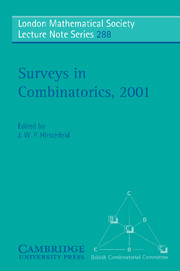Book contents
- Frontmatter
- Dedication
- Contents
- Preface
- Crispin Nash-Williams
- The Penrose polynomial of graphs and matroids
- Some cyclic and 1-rotational designs
- Orthogonal designs and third generation wireless communication
- Computation in permutation groups: counting and randomly sampling orbits
- Graph minors and graphs on surfaces
- Thresholds for colourability and satisfiability in random graphs and boolean formulae
- On the interplay between graphs and matroids
- Ovoids, spreads and m-systems of finite classical polar spaces
- List colourings of graphs
Ovoids, spreads and m-systems of finite classical polar spaces
Published online by Cambridge University Press: 05 August 2013
- Frontmatter
- Dedication
- Contents
- Preface
- Crispin Nash-Williams
- The Penrose polynomial of graphs and matroids
- Some cyclic and 1-rotational designs
- Orthogonal designs and third generation wireless communication
- Computation in permutation groups: counting and randomly sampling orbits
- Graph minors and graphs on surfaces
- Thresholds for colourability and satisfiability in random graphs and boolean formulae
- On the interplay between graphs and matroids
- Ovoids, spreads and m-systems of finite classical polar spaces
- List colourings of graphs
Summary
Abstract
A survey of the most important results on partial m-systems and m-systems of finite classical polar spaces will be given. Also, the paper contains several recent results on the topic. Finally, many applications of m-systems to strongly regular graphs, linear projective two-weight codes, maximal arcs, generalized quadrangles and semi-partial geometries are mentioned.
Introduction
Let P be a finite polar space of rank r ≥ 2. An ovoid O of P is a pointset of P, which has exactly one point in common with each generator of P, that is, with each maximal totally singular subspace of P. A spread S of P is a set of generators, which constitutes a partition of the pointset. It appears that ∣O∣ = ∣S∣ for any ovoid O and any spread S of any given polar space P; this common number will be denoted by μP. Ovoids and spreads have many connections with and applications to projective planes, circle geometries, generalized polygons, strongly regular graphs, partial geometries, semi-partial geometries, codes, designs.
A partial msystem of P, with 0 ≤ m ≤ r − 1, is any set {π1, π2,…,πk} of (k≠0) totally singular m-spaces of P such that no generator containing πi has a point in common with (π1 ∪ π2 ∪ … ∪ πk) − πi,πk, with i = 1, 2,…, k. For any partial m-system M of P the bound ∣M∣ ≤ μP holds. If ∣M∣ = μP, then the partial m-system M of P is called an m-system of P.
- Type
- Chapter
- Information
- Surveys in Combinatorics, 2001 , pp. 241 - 268Publisher: Cambridge University PressPrint publication year: 2001
- 10
- Cited by

